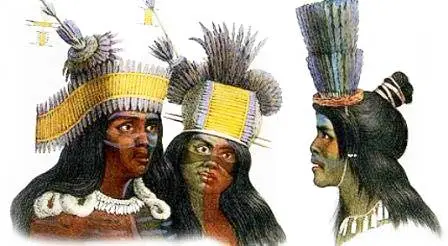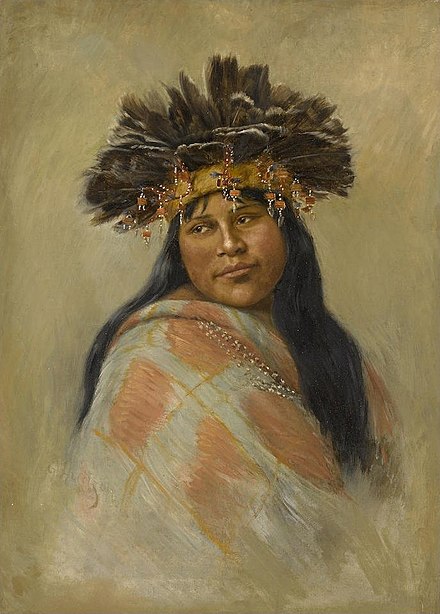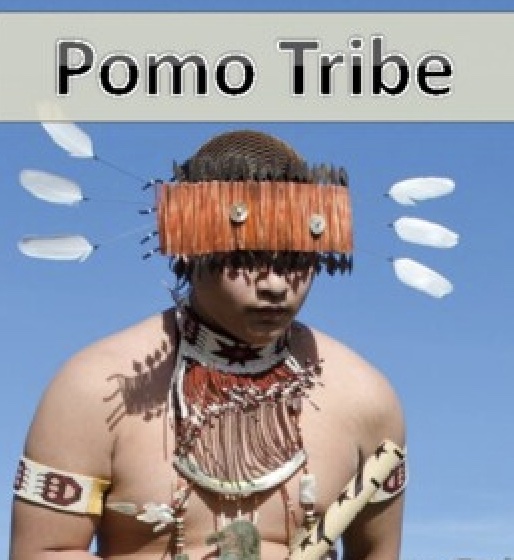The Pomo tribe is a group of Native American people who originally lived in California. Historically, the Pomo tribe had a vast area of land under its control. Today, many of the groups are officially recognized by the United States including the Big Valley Band and the Dry Creek Rancheria groups. Traditionally the different Pomo tribes were linked together by where they lived and the language they spoke although they weren’t all united under the name of a single tribe. The original territory of the Pomo tribe — the collection of all the smaller tribes — extended from the Pacific all the way to the inland California Clear Lake. Although most of the groups contained within this tribe were located in the same region there is a small Pomo tribe, which was separated and lived in a different area. The tribe is thought to have originally descended from people who lived in the Sonoma County in California. This would have been a coastal area filled with redwoods. Around 9,000 years ago, the first people to migrate to the Clear Lake began their journey which was the start of the Pomo tribe’s development.

The Pomo people inhabit northern California near Clear Lake and have a strong mythology of creation and world order. It includes the personification of the Kuksu or Guksu healer spirit, spirits from six cardinal directions, and the Coyote as their ancestor and creator god. The Pomo people participated in shamanism; one form this took was the Kuksu religion that was held by people in Central and Northern California. It included elaborate acting and dancing ceremonies in traditional costume, an annual mourning ceremony, puberty rites of passage, shamanic intervention with the spirit world, and an all-male society that met in subterranean dance rooms. The Pomo believed in a supernatural being, the Kuksu or Guksu (depending on their dialect), who lived in the south and who came during ceremonies to heal their illnesses. Medicine men dressed up as Kuksu.

The Pomo Indians are a tribal people who lived on the west coast of the United States, primarily north of what is currently San Francisco in the state of California. They were generally known as a particularly wealthy tribe, living in an area with abundant resources and other advantages. The tribe lived near a salt deposit, which was a useful trade item, and they also lived near magnesite, which was used in the crafting of beads. At one time, Pomo Indians occupied a relatively large area of land, but they were only able to hold on to approximately 50 acres (20.23 hectares) of it. They have always been highly regarded for their skill and artistry in the area of basket-making — their baskets are very colorful, using a variety of materials including feathers and many kinds of wood. Historical Pomo Indians lived in many different environments, from coastal areas to forests—because of this, their housing varied significantly. Those that lived near the sea made their houses out of bark and hard timber, while those that lived further inland generally made houses out of softer materials like grass and mats. There was no real concept of land ownership among the Pomo Indians, and they generally shared everything with the community, including hunting grounds.

The Habematolel Pomo of Upper Lake descend from four pre-contact tribes known as the Xowalek, Danoxa, Yobotui and Kaiyao-Matuku. These four tribes occupied the region of Upper Lake, California since time immemorial. This area was known as Pomo Country. A series of unjust and grievous federal policies forever altered the fate of the Tribe. On May 15, 1850, the 1st Dragoons Regiment of the U.S. Cavalry assaulted the population of the Tribe’s ancestors, predominantly women and children, in an aggressive military operation known as the Bloody Island Massacre. Few survived. The following year the United States promised lands to the Tribe’s ancestors in a federal treaty that was executed, but, sadly, never ratified. In 1856, the Pomo of Lake County were gathered and forced to live on the newly established Nome Cult Indian Farm in Round Valley. In 1878 the local Pomo tribes united and communally purchased 90 acres of land north of Upper Lake and established a traditional community known as Habematolel, or ‘the people of rock village.’

The Pinoleville Pomo Nation is a small band of the greater Pomo Tribe of Northern California. The Pinoleville Pomo Nation is originally from Potter Valley, California, located eighteen miles (29 km) north-northeast of Ukiah, California where the Pinoleville Pomo Nation currently resides. Prior to the arrival of the European colonizers, there were three main villages in Potter Valley called Pomo, Sedam (or Tse tum) and Canel (or Shanel, Sanel), and several smaller villages and camps. These villages remained connected and cooperative with each other through marriage, and ceremonies. They were governed by councilmen called tca ka-li in Northern Pomo, also sometimes known as captains.

The Pomo Indians traditionally lived in what is now northwestern California around the Clear Lake area north of San Francisco, and along the Russian River, in Lake, Mendocino, and Sonoma Counties. Today, there are about 5,000 Pomo living in several rancherias and reservations on or near the places of their origin.
BANDS OF THE POMO TRIBE AND THEIR RESERVATIONS
- Big Valley Band — Big Valley Rancheria
- Cloverdale Group — Cloverdale Rancheria
- Coyote Valley Band — Coyote Valley Rancheria
- Dry Creek Group — Dry Creek Rancheria
- Elem Indian Colony — also known as the Sulphur Bank Rancheria
- Grindstone Rancheria
- Guidiville Rancheria
- Hopland Band — Hopland Rancheria
- Kashia Band — Stewarts Point Rancheria
- Little River Band — Potter Valley Rancheria
- Lytton Rancheria
- Manchester Band — Manchester-Point Arenas Rancheria
- Middletown Group — Middletown Rancheria
- Pinoleville Group — Pinoleville Rancheria
- Potter Valley Group — Potter Valley Rancheria
- Redwood Valley Group — Redwood Valley Rancheria
- Robinson Rancheria
- Round Valley Reservation
- Scotts Valley Band — Scotts Valley Rancheria
- Sherwood Valley Group — Sherwood Valley Rancheria
- Stewarts Point Rancheria
- Sulphur Bank Rancheria
- Upper Lake Band — Upper Lake Rancheria

Pomo Indian Language (Yakaya, Yokaia, Shanel, Kábinapek, Gallinomero)
Pomo language samples and resources.
Information and links about the Pomo tribe past and present.
Our answers to common questions about the lifestyle of Pomo Indian people.
Pomo Legends
Pomo Words
Our list of vocabulary words in the Central and Eastern Pomo languages, with comparison to words in other Hokan languages.
Pomo Animal Words
Illustrated glossary of animal words in the Pomo language.
Northern Pomo
Encyclopedia articles on the Pomo Indian languages.
Lenguas Pomoan
Pomo Langue
Pomo information in Spanish and French.
Pomos
Pomo links pages.
Pomo Tribe
Pomo Indian books.

Pomo, Hokan-speaking North American Indians of the west coast of the United States. Their territory was centred in the Russian River valley some 50 to 100 miles (80 to 160 km) north of what is now San Francisco. Pomo territory also included the adjacent coastlands and the interior highlands near Clear Lake. A small detached group lived in the Sacramento River valley surrounded by Wintun people. Traditionally, the Pomo were a comparatively wealthy people, well supplied with food and other natural resources. Fish, waterfowl, deer, acorns, bulb plants, seeds, and other wild foods were plentiful. Northeastern Pomo settlements held a lucrative salt deposit, and southeastern settlements had magnesite, a substance that was combined with ground shells and made into the beads that were used as standard currency in north-central California.

The Pomo are an Indigenous people of California. Historical Pomo territory in Northern California was large, bordered by the Pacific Coast to the west, extending inland to Clear Lake, and mainly between Cleone and Duncans Point. One small group, the Tceefoka (aka Northeastern Pomo), lived in the vicinity of present-day Stonyford in Colusa County, separated from the core Pomo area by lands inhabited by Yuki and Wintuan speakers. The name Pomo derives from a conflation of the Pomo words [pʰoːmoː] and [pʰoʔmaʔ]. It originally meant “those who live at red earth hole” and was once the name of a village in southern Potter Valley near the present-day community of Pomo, California in Mendocino County. It may have referred to local deposits of the red mineral magnesite, used for red beads, or to the reddish earth and clay, such as hematite, mined in the area. In the Northern Pomo dialect, -pomo or -poma was used as a suffix after the names of places, to mean a subgroup of people of the place. By 1877, the use of Pomo had been extended in English to mean the entire people known today as the Pomo.

The Pomo tribe live in parts of Sonoma, Lake, Mendocino, Colusa, and Glenn Counties in California. The word ‘Pomo’ means “those who live at red earth hole” in reference to their earth lodge pit houses that were built with a red colored earth as the winter homes of the tribe. Their tribal lands were subject to various incursions by the Russians, Spanish, Mexican and finally the Americans. The Pomo people were made slaves by many of these invaders and watched as their tribal lands fell to the Russian traders seeking sea otter furs, the Spanish who wanted to convert the tribe to Christianity, the Mexicans who forced the people to work on their farms and finally the Americans who moved west along the California Trail who were joined by the Gold Rush settlers. The Pomo were decimated by the diseases brought by the invaders and those who survived were forced on to various reservations.

The seven Pomo groups are: Southwestern (or Kashaya) Pomo; Southern Pomo; Central Pomo; Northern Pomo; Northeastern (or Salt) Pomo; Eastern (or Clear Lake) Pomo; Southeastern (or Lower Lake) Pomo. The heart of Pomo land was the valley of the Russian River. Their territory extended across the Coast Range mountains to the ocean on the west, and to Clear Lake on the east. Though some villages were along the ocean and some near Clear Lake, many more were located in the Russian River valley. Even the people near the coast preferred to have their settlements away from the ocean by some miles, along a river or creek. The name Pomo may have come from a Northern Pomo word that was added to place names when referring to people who live at that place, as in Buldam-pomo, meaning people who live at Buldam. A community was made up of several villages with one main village where the headman lived. There were several hundred small villages in Pomo territory, but only about 75 main villages. Each community had certain land on which they had the right to hunt and fish. In some communities, individuals owned certain trees or fishing spots. The number of headmen differed between the groups of Pomo. Some communities had one; some had several; one Central Pomo community is said to have had 20 chiefs all at the same time, each having a specific job in the community.
















